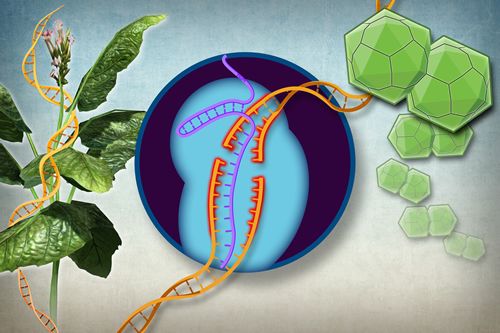The November Genome Advance of the Month describes how these scientists inserted the code for an ancient bacterial immune system into a plant's genome to successfully strengthen the plant's protection against viruses. Featured in Genome Biology, this research represents a promising method for cultivating plants' resistance to harmful viruses.
Understanding plant genomics is valuable for human nutrition and health. In addition to playing an essential role in our ecosystem, plants sustain our bodies and economies. Crop losses, particularly due to DNA plant viruses, can threaten international food security and cause significant economic losses. After looking at the machinery of simple organisms like bacteria, scientists set out to answer whether the machinery that bacteria have long used to protect themselves from viruses - CRISPR/Cas9 - can also be used to protect plants. CRISPR/Cas9 (which stands for clustered regularly interspaced short palindromic repeats and a protein called Cas9) allows scientists to snip out segments of an organism's DNA and insert new ones.
While using the system to advance technology, scientists are also thinking critically about the ethical, legal, and social concerns of CRISPR/Cas9 technologies. The recent International Summit on Human Gene Editing focused on these issues, including the concern that CRISPR/Cas9 could be misused in the editing of human traits.* With these ethical issues always in mind, scientists have begun using the technology in diverse areas of research.

In this study, a group of scientists used the CRISPR/Cas9 system to make changes in the genome of a tobacco plant species called Nicotiana benethamiana. This plant species was chosen because it is well understood as a model organism, and new findings can be easily applied to other species. Tobacco plants are susceptible to a destructive virus called tomato yellow leaf curl virus, which leads to stunted growth, abnormal leaves, and increased fruit death. Currently, there's no effective way to restrict or eliminate the spread of the tomato yellow leaf curl in plants, making it a challenging and expensive problem. A method that protects against this virus would benefit plant health and crop yield.
Once the tomato yellow leaf virus infects the plant's DNA, the virus replicates rapidly. The infection, in fact, depends on the virus' ability to make copies of itself. To replicate, the virus needs an intact DNA viral genome. Thus, this group of scientists hypothesized that by training the CRISPR/Cas9 system to recognize and make cuts in the virus' DNA sequence, they could interfere with the virus's survival and improve the plants' resistance to the virus.
In a two-step process, the scientists introduced the virus' sequence into the CRISPR/Cas9 system and inserted the CRISPR/Cas9 system into the tobacco plant's genome. After this insertion, when the plant encountered the tomato yellow leaf curl virus, the CRISPR/Cas9 system chopped up the virus DNA. Because of its cut DNA, the virus was unable to replicate. By targeting and degrading the virus DNA, the CRISPR/Cas9 system broke the viral machinery, which in turn eliminated or reduced in the plant's disease symptoms. The scientists also found that the system can be used to specifically target and provide resistance to many other viral strains in the future.
This research offers promising possibilities for the future of plant genomic engineering and suggests exciting methods to improve crop yield, protect plants and preserve food security. This research has planted seeds for intriguing advances in gene-editing and improvements in agriculture.
Read the article
Ali Z., Abulfaraj A., Idris A., Ali S., and Mahfouz M. CRISPR/Cas9-mediated viral interference in plants. Genome Biology, 16(1):238. 2015. [Full Text]
International Summit on Human Gene Editing (http://www.nationalacademies.org/gene-editing/Gene-Edit-Summit/index.htm




